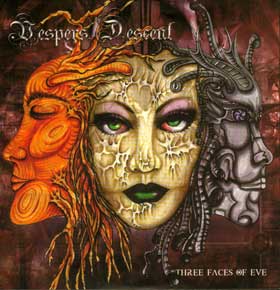
Home |
Up |
Prev |
Next |

Vespers Descent - Three Faces Of Eve
Because there are an infinite number of dimensions and an awareness may be limited to any number of these, each Uru can be manifested in an infinite number of ways; as an infinite number of aga. Because they are all manifestations of the same Uru they are all related. Aga that are thus related are termed "conjugate aga" or taga1.
The complexity and richness of an agu is determined by the number of dimensions of space and time that it is aware of. This is true not only for the body and but also for the mind. This is because the electrical activity is more complex with more dimensions. And this richness and complexity is not just limited to thought but applies to all spheres of the mind including emotions, feelings, desires, willpower and so on.
Imagine how amazing it must be to add a new dimension to your emotions... to raise your feelings to the power of 2! To raise the depth of your thought to the power of 3! To experience desire to the power of 10!!! All this and infinitely more is yours!
Changing consciousness to a different Shoku means not only a different environment but a different sense of self, we are now a tagu of the agu we were. However, because we are still manifestations of the same Uru, there is also a feeling that we are somehow the same. No matter how we manifest, our agu still exhibits part of the quality of our Uru; just as one toe exhibits part of the quality of the whole person; you can compare an ear and a toe from the same person and although they exhibit many differences, they also exhibit similarities, and most importantly; they belong together.
This is true also for kala, they too have conjugate manifestations in all Shoka, known as tala2. A particular house in another Shoku, despite great differences, will still exhibit some characteristics that enable one to recognise it as the talu of the original house.
The degree of similarity between 2 Shoka depends on the number of dimensions in common, the number in total and the difference in time dimensions.
s = d + Δt - c
where:
"s" is the degree of similarity between the conjugates
"d" is the total number of dimensions
"c" is the number of dimensions in common
"Δt" is number of time dimensions changed
For example if one changed from time dimension "a" to time dimension "b" then the number of time dimensions changed would be 1. If one changed from "a" to "e,f" then it would be 2.
Here is a table detailing the relationship between some of the Shoka most relevant to us. Dimensions are symbolised with a single letter. The time dimension(s) are accorded an asterisk. For the sake of this table the dimensional symbols for Orithia are x,y,z & t.
| Shoku1 | Shoku2 | Transformation | d | c | Δt | Similarity | Number Conjugates | Name |
| (x,y,z,t*) | (x*,y,z,t) | Swap time axis | 4 | 4 | 1 | 1 | 4 | |
| (x,y,z,t*) | (x,y,t*) | Spatial reduction by 1 dimension | 4 | 3 | 0 | 1 | 3 | |
| (x,y,z,t*) | (w,x,y,z,t*) | Spatial augmentation by 1 dimension | 5 | 4 | 0 | 1 | infinite | |
| (x,y,z,t*) | (x,t*) | Spatial reduction by 2 dimensions | 4 | 2 | 0 | 2 | 3 | |
| (x,y,z,t*) | (v,w,x,y,z,t*) | Spatial augmentation by 2 dimensions | 6 | 4 | 0 | 2 | infinite | |
| (x,y,z,t*) | (x,y,z,s*,t*) | Temporal augmentation by 1 dimension | 5 | 4 | 1 | 2 | infinite | |
| (x,y,z,t*) | (x,y*,t) | Complex reduction by 1 dimension | 4 | 3 | 1 | 2 | 12 | |
| (x,y,z,t*) | (w,x*,y,z,t) | Complex augmentation by 1 dimension | 5 | 4 | 1 | 2 | infinite | |
| (e1*,e2...en) | (e1,e2...en*) | Swap time axis | n | n | 1 | 1 | n | |
| (e1*,e2...en) | (e1*,e2...en-1) | Spatial reduction by 1 dimension | n | n-1 | 0 | 1 | n-1 | |
| (e1*,e2...en) | (e1*,e2...en+1) | Spatial augmentation by 1 dimension | n+1 | n | 0 | 1 | infinite | |
| (e1*,e2...en) | (e1*,e2...en-2) | Spatial reduction by 2 dimensions | n | n-2 | 0 | 2 | n-1Cn-3 | |
| (e1*,e2...en) | (e1*,e2...en+2) | Spatial augmentation by 2 dimensions | n+2 | n | 0 | 2 | infinite | |
| (e1*,e2...en) | (e1*,e2*...en+1) | Temporal augmentation by 1 dimension | n+1 | n | 1 | 2 | infinite | |
| etc |
- Taga (pronounced tah-gah), (tagu singular).
- Tala (pronounced tah-lah), (talu singular).